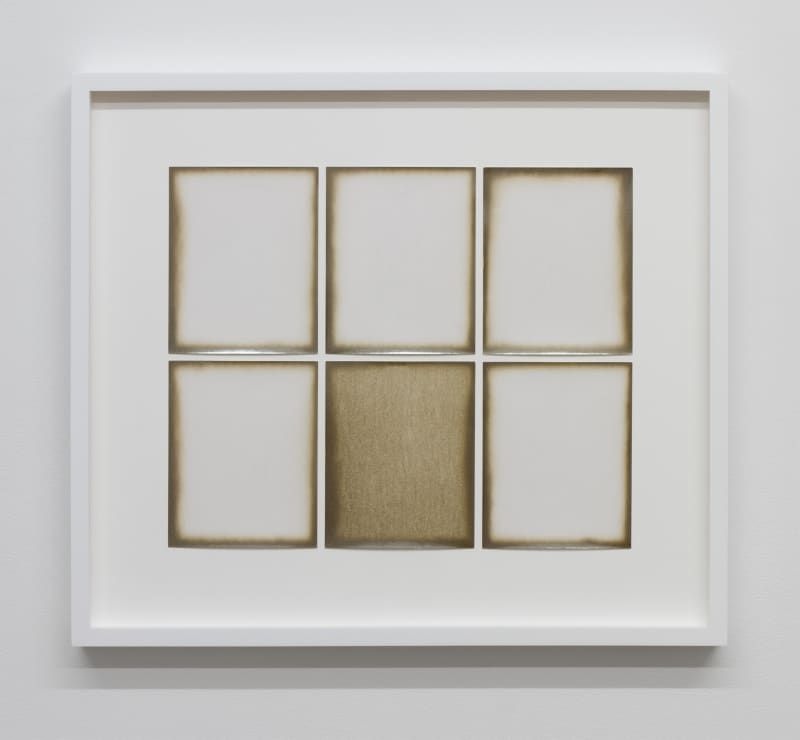"Every photograph is a certificate of presence," wrote Roland Barthes in his 1980 book Camera Lucida, the final and most personal of his many engagements with the medium. The presences Barthes had in mind-an ancient house, a table set for dinner, strangers and loved ones-were at once corporeal and temporal, representing specific moments of physical tangibility fixed precisely in time by light and chemistry. The elegant, conceptually expansive work of Alison Rossiter also conjures extraordinary ordinary presences, but of a very different kind. Since
2007, the artist has been collecting expired vintage photographic paper and developing it using basic black-and-white processes. The cameraless pictures she produces may be depopulated, but they are by no means without subjects. The interactions between her latent materials and their darkroom baths yield a surprisingly rich range of abstract imagery, revealing time's traces inscribed on the very skins of the photographs themselves.
At Yossi Milo Gallery, the works in Rossiter's show "Substance of Density 1918-1948" are made with rare papers dating to the three decades named in the exhibition title, a period that saw important cultural movements and the creation of indelible
artistic artifacts, as well as social and economic chaos and the unprecedented carnage of modern global warfare. (It is only a dark coincidence that the first year of Rossiter's date frame is that of the eruption of the Spanish flu, the last pandemic,
which infected roughly one-third of the world's population, killing as many as fifty million people in a span of two years.) Framed both singly and in carefully conceived multipart compositions, the pieces are all titled after the expiration dates of the substrates on which they are made. The oldest papers here appear in Eastman Kodak Azo, expired March 1918, processed 2010 (#5) and (#2). The former is a misty gray and mottled, while the latter is night-dark and punctuated by
nebular patches of white. Both sheets went bad the same month that Leon Trotsky was put in charge of the Red Army; the silent comedy The Bell Boy, starring Fatty Arbuckle and Buster Keaton, was released; and painter Elaine de Kooning was
born. It's impossible to know precisely what external events during their lifespan produced the effects that Rossiter's intervention calls forth, and it's that sense of time-traveling contingency that gives the project so much of its interest. The
full results of her encounters with her materials remain uncertain until the moment of truth.
Though the specific mechanics of the processing were for the most part obscured, Rossiter's darkroom procedures did show through in a few cases, particularly in Gevaert Gevaluxe Velours, exact expiration date unknown, ca. 1930s,
processed 2020 (#1) and (#2), where the stark division between dark and light suggests a strategic limiting of the paper's contact with the developer. Large single-panel images like these are hung on their own, while the smaller and more
numerous multisheet pieces are organized into a pair of salon-style suites. At first glance, Rossiter's presentation might seem like a traditional exegesis on the monochrome. The three-by-three grid Density 1936, 2020, with its eight flat-white
sheets balanced by a single beige rectangle at the top left of the composition-a slab of gingerbread awaiting its vanilla frosting-called to mind the paintings of Robert Ryman. But most works on view are built from papers of more variegated
tones, the range of which is surprisingly extensive given the generally narrow palette available to them-blacks in various degrees of saturation; grays from charcoal to gunmetal; whites, taupes, and creams. They also bear gorgeously subtle variations, as in the diptych Density 1941, 1945, 2020, which evokes night-vision images of a forest, or Density 1930s, 2018, in which each of two differently sized panels contains a central patch of light progressively swallowed around the
edges by a dappled veil. Here, as elsewhere, Rossiter's recuperative gesture placed two opposed moods into poignant, productive dialogue, evoking the melancholy of desuetude, yes, but also the possibility that something might yet still be recovered from what at first seems to be nothing at all.

